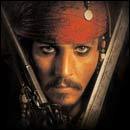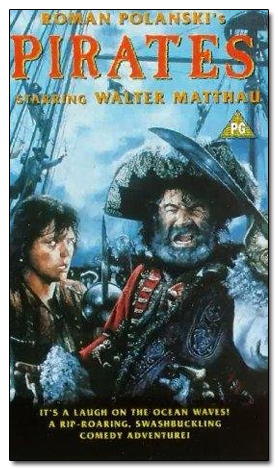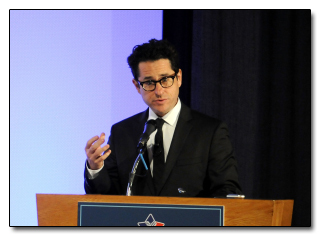5 Classic Movies That Seemed Like Terrible Ideas At The Time

The thing about a huge pop-culture phenomenon is that it seems so obvious after the fact. It's impossible to imagine people not going wild for something like Star Wars. But at the time, when the checks were being written and not a single ticket had been sold? Yeah, it was a different story. In fact, a lot of the biggest hits in Hollywood history sounded absolutely ridiculous in concept.
So let's start with ...
Star Wars

You are an executive at a movie studio. A young director is coming off a hugely successful movie about teens in 1960s America called Amerian Graffiti. For his next project, he wants more than 10 times that budget to shoot a huge special effects feature with the catchy title Adventures of Luke Starkiller, as Taken from the Journal of the Whills, Saga I: The Star Wars. The original two-page treatment where he outlines the story begins, "This is the story of Mace Windy, a revered Jedi-bendu of Ophuchi, as related to us by C.J. Thorpe, padawaan learner to the famed Jedi."

"Oh, and he says 'motherfucker' a lot."
Do you write this man a huge check? Or do you call security?
It Seems Obvious Now ...
When it comes to blockbuster movie franchises, Star Wars feels like cheating. A simplistic story of good and evil told over the backdrop of the greatest special effects ever filmed and featuring a smirking Harrison Ford in his prime? Add in the fact that everything you saw on screen could be turned into a kick-ass toy or action figure and it seems like the Hollywood version of an infinite money cheat code. That's how it looks now.

George Lucas: Proof that you don't need the support of a giant studio to sell out.
But at the Time ...
Actually, even George Lucas didn't really want to make Star Wars. He wanted to give us a 1970s reboot of the 1930s sci-fi adventure series Flash Gordon. But the rights had already been purchased by Italian producer Dino De Laurentiis, so Lucas had to build his own version effectively from scratch. His own expensive, totally incoherent version.

"Underneath every stormtrooper's helmet is Dino De Laurentiis' head."
And what reason did anyone have to think that Lucas could make a world-changing fantasy blockbuster? The only thing remotely similar on his resume was 1971's THX 1138, a bleak, weird film that had been dismissed as incomprehensible by the studio and bombed at the box office. So imagine being the studio executives when this bearded guy brings in his 200-page script that, as we have pointed out before, was a confusing mish-mash of insanity. Even personal friends of Lucas admitted that they couldn't understand what the script was about.
Sure enough, the studio, Universal, passed, but 20th Century Fox stepped in and gave Lucas $8.5 million, maybe because they were afraid of what he might do otherwise.

If they'd have only known ...
So then Lucas flew off to shoot in Great Britain and Tunisia, while in the U.S. a team of untried special effects artists gathered to start making movie magic. After a year, that FX team had blown half their budget and had exactly three usable special effects shots to show for it. Lucas and some Fox executives dropped in on them to find out what the hell was going on and found the crew standing around, having a refrigerator lifted and dropped on the concrete in front of them because "everyone kinda wondered how it would sound."

And that's where the Death Star explosion came from.
Things weren't going any better in Europe, where Lucas's British crew began to openly mock and rebel against him, taking breaks without permission and refusing to work the long hours they'd need to meet the deadline. The production soared over budget.
But once the actual movie was completed, everybody realized what a work of genius it was, right?

Nope. No theater chain wanted it -- the sci-fi fantasy was completely out of step with the sci-fi hits of the era (they were all dark, adult films like Soylent Green and Logan's Run). To avoid having to just sit on this expensive turkey, 20th Century Fox resorted to underhanded means to get it into theaters -- they told the theaters they couldn't have an upcoming hit (The Other Side of Midnight) unless they agreed to take this Star Wars turd along with it (a practice that is actually illegal).
Thus, Star Wars was booked into a whopping 39 theaters for its grand opening in the hopes that it would at least make a little bit of its money back. All but one of those theaters saw this weird sci-fi fantasy break their all-time attendance records. At the end of all that, the crazy bearded guy was right.

That's a wedding, 30 years after the movie's release.
Pirates of the Caribbean

The pitch had to have sounded something like this: "So, I know that literally every single pirate movie ever made has been a bomb. But this one will be based on a Disney ride. And it will star that weird guy from all of those Tim Burton movies. Oh, and I'll need $140 million."

"We're not sure if he's gay or not, but we think we can keep the audience guessing, too."
It Seems Obvious Now ...
The Pirates of the Caribbean franchise boasts four movies and over $3.6 billion in worldwide box office, plus billions more in DVD, merchandise and video games. And why not? The math is unbeatable: Disney, plus Jerry Bruckheimer, plus Johnny Depp hamming it up in his most famous role, plus monstrous special effects budgets. The only mystery here is why nobody thought of it before.

We know, you're rich. You can stop gloating now.
But at the Time ...
It had been thought of before. And each time, it was a disaster.
It started in 1986, when Roman Polanski did the huge-budget film Pirates. It cost $40 million to make, an absurd number in 1986 money (by comparison, the effects-heavy Star Trek IV that came out the same year cost only $21 million, and it was the most expensive Trek movie ever made). And what did they get for their $40 million investment? Less than $7 million in box office worldwide.

Walter Matthau couldn't quite make the leap from zany football coach to dashing pirate.
OK, so maybe that was an isolated incident. A decade later, Hollywood tried again with Cutthroat Island -- a pirate movie with a $100 million budget, directed by the guy who made Die Hard 2. It was an even bigger disaster -- it only made $10 million on its nine-figure investment. Even Steven Spielberg's Hook was a disappointment. So was Muppets Treasure Island, and it had the Muppets AND Tim Curry. Oh yeah, and also there was a little movie called Treasure Planet that was made and released just a year before PotC ... that was the biggest bomb in Disney's history. Holy shit! Pirates are freaking box office poison.

"Now that we've eaten all the studio's money, let's go shit it over there."
After all that, you have these nutjobs asking for $140 million to make another pirate movie. And the draw is, what, the freaking Disney World ride? Don't say that Johnny Depp was supposed to put asses in the seats -- his biggest box-office hit at the time he was cast was Tim Burton's Sleepy Hollow. His next biggest hit? Chocolat. Neither of which made as much as this pirate movie's proposed budget.
The whole thing plays out like Disney was trying to intentionally lose money for some complicated investment scheme, like in The Producers. When it made $46 million that first weekend, you can just imagine a couple of conniving producers screaming "Goddamnit!"

Yes, we KNOW, already!
The Blair Witch Project

If you're a struggling actor, how desperate would you have to be to reply to a listing that goes something like:
"WANTED: A group of actors to spend eight cold days in the woods shooting a fake documentary. This is an independent project. There is no script. You will be traumatized and your reaction will be captured on camera. After the movie, you must avoid the public eye and we will tell people you are dead."

"Oh, no problem, dude. I was planning on doing that anyway."
Would you even expect to come back from that kind of project alive? It sounds like a snuff film intended to be sold on the streets of Thailand.
It Seems Obvious Now ...
Combining everything we hate about shaky-cam, viral marketing and reality shows, the no-budget The Blair Witch Project would make nearly $250 million worldwide. Or, to put it another way, it made back its budget 10,000 times over. The 25 grand they spent making the thing wouldn't even cover a month's worth of catering costs on most studio films.

And that's just for George Lucas. OOOOOH, BAM!
It did it all with a unique hook and an ingenious marketing plan, creating a viral Internet campaign back in 1999, when most studios were still trying to figure out what the Internet even was. They promoted the faux-documentary as a true story, indicating that all of the characters had been killed (actors were prevented from doing publicity until close to release to keep up the illusion). Their website was full of hidden clues and extra materials -- the template for the "alternate reality games" filmmakers like J.J. Abrams now do with every release.

"I'm sorry. I have a legitimate problem, and I'm seeking help."
The filmmakers clearly had a plan, and with so little invested, how could it fail?
But at the Time ...
Actually, The Blair Witch Project was about the most stupid thing writers/directors/producers Eduardo Sanchez and Daniel Myrick could have done.

"Jackass auditions were closed."
First, you have to realize that a studio didn't fund this. So when we talk about $25,000 being "no-budget," that's true if you're talking about Disney or Paramount. That's not true for a couple of dudes who had no careers to speak of. And that was the situation in October of 1997 -- the filmmakers behind Blair Witch were an unsuccessful pair in their late 20s and mid 30s, both deeply in credit card debt. So what did they do? They conceived of a highly experimental Hail Mary final project that would drive them tens of thousands of dollars deeper into debt. The project had literally no commercial prospects -- a no-name cast, no specials effects and no distribution lined up. The film was shot on hand-held cameras that weren't even in widescreen and that, by the way, caused motion sickness for the audience. For them, it was like trying to bail out a sinking boat by vomiting in it.

The same handprints were found in theaters after the movie finished.
But those two couldn't bring all the stupid to the table alone. They needed to find a cast of three alleged film students who would agree to go camping, in the cold, on camera, with little food and supplies (the filmmakers wanted their physical distress to look genuine). Needless to say, they didn't exactly get the cream of the crop here. One of the stars would be the recently recovered heroin addict Joshua Leonard. Oh, and he would be the one operating the camera. During the early scenes, he couldn't get the camera to focus properly and wrecked a lot of the footage. Later in the woods, he rolled down a hill and broke the $10,000 camera.

We guess they're lucky he didn't sell it for smack.
Again, this isn't studio equipment here. Imagine you're these two filmmakers, trying this never-before-tried filmmaking method out in the woods, and seeing $10,000 of money you don't have go tumbling down a hill. Now imagine that the two other actors fuck up just as often, managing to get lost despite having walkie-talkies, compasses and clear directions on where they were supposed to go for the next day's shoot. And along the way, they're arguing with each other so much that director Eduardo Sanchez estimated 10 hours of fits and bitchfests were shot.

"YOU SAY MEAN THINGS TO THE FACE OF MY NECK RAARR!"
Never mind the unlikelihood that this movie would become as big as it did: the real miracle was that there was any footage that survived to make into a movie in the first place. But they edited their piles of tape down to a brisk 90 minutes, hoping to get a deal to show it on cable or maybe direct-to-video. Instead, a studio bought the rights for $1.1 million, and in its first weekend of wide release, The Blair Witch Project made back 35 times that amount.
Schindler's List

"With Jurassic Park a surefire hit, I'm thinking about following it up with a subject no moviegoer can resist: the Holocaust. Also, it'll be more than three hours long. And in black and white. And much if it won't be in English."

"The real guy looked kinda flabby, so we'll have to sex it up with Liam Neeson."
It Seems Obvious Now ...
Well, of course Steven Spielberg can make that into a success. He could do a movie applauding the Holocaust and people would go see it. Seven Academy Awards, $321 million in worldwide box office later, not a single year goes by without another Holocaust movie featuring some big star or other. Why not? What subject is more ripe for drama than that?

That's right before he gets killed by Darth Maul.
But at the Time ...
Drama? Yes. Money at the box office? Shit, no. Look on a list of all the Holocaust movies ever made and the closest thing you find to a hit before Schindler's List is 1982's Sophie's Choice, and it had the advantage of being based on a best-selling novel (Thomas Kenneally's Schindler's Ark, the book Schindler's List was based on, was not a bestseller).
In interviews, Spielberg quoted an executive "that will remain nameless" as asking why instead of making this movie, Spielberg and Universal didn't just make a gigantic donation to the Holocaust Memorial Museum. Why waste the money shooting a movie nobody was going to see anyway?

Replace that human shit with money, and you get the picture.
It's not like Spielberg's 1987 film Empire of the Sun had done anything to increase interest in the Japanese occupation of China during World War II (until this moment, did you even realize that's what that movie was about?). And no one who had just sat through that, The Color Purple, Always, Hook, or Indiana Jones and the Temple of Doom had much reason to expect the director of those five movies to know how to avoid making a movie where Nazi cartoons kill a bunch of Jewish cartoons. During a party, Fred Schepsi, one of Kenneally's original collaborators, yelled at Spielberg, "You'll fuck it up!"

"Though to be fair, I have no clue what I'm talking about."
Hell, Spielberg himself guaranteed that the studio would lose all their money. That's why they had suggested he just donate it -- it was basically just charity anyway.
Or so they thought. Schindler's List wound up as one of the top-10 highest grossing movies of the year. This 195-minute Holocaust depress-a-thon finished ahead of lighthearted hits like Free Willy and Groundhog Day.

You leave Bill Murray alone, Holocaust!
Spielberg himself didn't make anything, having waived his directorial fee and donated his personal profits -- to the tune of $53 million -- to start up the Righteous Persons Foundation.
Snow White and the Seven Dwarfs

"Here's an idea -- a movie about genetic freaks, made with a budget that's more than the total value of the studio. Also, it'll be a feature-length animated movie, and we've never, ever made one of those before."

Is it just us, or does Disney look like a pimp in that picture?
It Seems Obvious Now ...
As big of a deal as you think Disney's Snow White and the Seven Dwarfs is, it's actually bigger than that. It's considered a big deal when a movie grosses $100 million, but Snow White sold 109 million tickets. If they'd charged today's ticket prices, it'd have made more money in the U.S. than Avatar, The Dark Knight ... just about any movie you can name. It was the first cog in the Disney animated money printing machine that would continue with features like Bambi and Cinderella, all the way through to modern-day mega-blockbusters like The Lion King and the Pixar films. And why not? They're classic stories that people of all ages can enjoy.

But at the Time ...
In 1937, animated movies were brand new, and successful animated movies weren't really a thing -- nobody had tried for a decade (the last one was 1926's German film The Adventures of Prince Achmed and it had been a flop). No animated feature had been made in the U.S. before. There had never been one made in color anywhere.
For that matter, movies themselves were still fairly new -- Disney had never made a feature film before, and when Walt Disney plunged ahead with his adaptation of the Snow White tale, the company didn't even know how to distribute the movie, or how much to charge for it (Charlie Chaplin would eventually lend him the reports from his own successful movies to use as reference). And with Snow White, Disney wasn't exactly dipping his toe into the waters -- the production would go 400 percent over budget, an amount more than the total value of the studio. It was less a sensible business venture than something your senile grandpa does at the casino.

"Put it all on red!" "Sir, this is a poker table."
And the movie was about dwarfs. During the 1930s in America, there were often forced sterilizations of people with any kind of abnormality. Movies with major dwarf characters such as Freaks and Terror of Tiny Town had bombed. No less an authority than Walt Disney's wife, Lillian, told Walt that nobody would pay to see "a dwarf picture." In the press the movie acquired the moniker "Disney's folly."
The movie would open to a successful theatrical run in 1937. It made so much money that when the studio needed cash in 1944, they released it again. And people flocked to see it, again. So they re-released it in 1952, 1958, 1967, 1975, 1983, 1987 and 1993. During that last release in 1993, this 56-year-old movie opened in the top five at the box office that week.

"Now that I'm rich, which one of you bitches gets the back of my hand first?"
Not bad, for a dwarf movie.
For more film knowledge to bug your friends with, check out 5 Awesome Movies Ruined By Last Minute Changes and 7 Terrible Early Versions of Great Movies.
And stop by LinkSTORM to discover many, many bad ideas.
And don't forget to follow us on Facebook and Twitter to get sexy, sexy jokes sent straight to your news feed.
Do you have an idea in mind that would make a great article? Then sign up for our writers workshop! Do you possess expert skills in image creation and manipulation? Mediocre? Even rudimentary? Are you frightened by MS Paint and simply have a funny idea? You can create an infograpic and you could be on the front page of Cracked.com tomorrow!